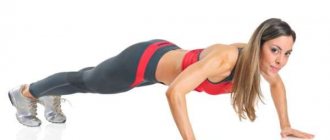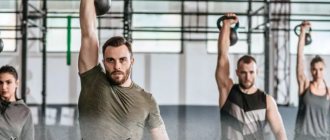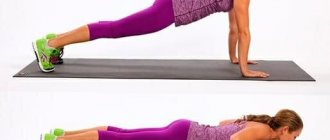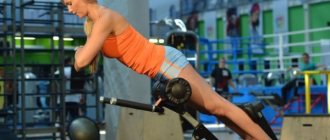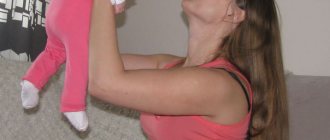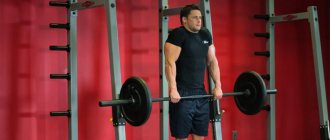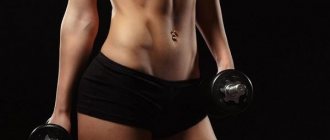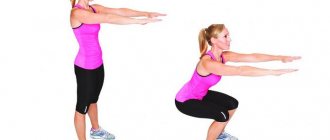How to pump up your legs?
The calf muscles are involved in any lower body exercise. With a sufficiently intense training plan, women do not need to specifically pump them up; the process of hypertrophy will be launched along with the development of the muscles of the buttocks and thighs. However, not everyone sees themselves as a regular client of the gym, and the following tips are collected for them.
- Walk more - this will keep your legs under constant tension. Moreover, the higher the speed of movement, the more intense the muscle tenses.
- Stair climbs are a great free exercise that is suitable for everyone. It’s easy to use – you just need to go up to the top floor of your own house several times a day, and after just a month your legs will noticeably tighten up.
- Sitting at your desk, place your feet on your toes. From this position, raise your heels as high as possible and lower them level with the floor. A simple movement will quickly tighten your shins.
Those for whom this is not enough should create a full-fledged workout with an emphasis on the lower body. Moreover, you can exercise both at home and in the gym.
Occurrence of the problem and anatomy
Calf training refers to the development of the calf and soleus muscles.
Civilization not only gave man benefits, but also added a number of problems. Among them, oddly enough, are improperly formed leg muscles, especially the calves. What does civilization have to do with it, you ask? And despite the fact that we began to walk much less.
Public transport and personal cars have taken away from us the treasured 10,000 steps a day, which we so need for beauty and health. The result is weak and unaesthetic calf muscles, with complexes about this in addition.
More and more girls can boast of frail cellulite sticks instead of beautiful female legs. And we won’t say anything about men at all: chicken legs sticking out of shorts look even more disgusting, especially if a carcass of impressive dimensions rises above them.
Even boys now prefer virtual football to real football and wait in the morning, shifting at the door from one thin leg to another, for their parent to drop them off at school, instead of walking five hundred meters. However, the problem of thin calves can be solved, like many things in our lives. And you can solve it without leaving your home. You just need a little patience and time.
We pump up the calf muscle at home
How to quickly pump up leg muscles with home workouts - it depends on the equipment used and the duration of the workout. However, you cannot devote the entire workout to the lower leg alone, because this muscle is small and gets clogged very quickly. Thus, women are recommended to perform 2-3 exercises for this muscle group, and a few more movements that involve the hips and buttocks.
Basic rules for homework:
- start training only after a good warm-up;
- perform the required number of approaches and repetitions;
- purchase sports equipment - step platform, dumbbells, etc.;
- end your workout with a cool down.
Running in place at an intense pace is suitable as a warm-up for your legs. Then it is recommended to swing your legs to the sides to warm up and stretch the muscles. After training, a cool-down or stretching is recommended; it will reduce the severity of pain and stiffness the next day after an intense workout. Instead of a cool-down, you can do self-massage.
The following simple exercises will help you quickly build up your calves.
Jumping rope
It is recommended to start your home workout with a jump rope. Jumping will perfectly warm up the body, prepare it for further stress, and also work the calves quite strongly. It is recommended to start with three sets of 100 jumps. This amount is enough for those who have never played sports before. If physical fitness allows you to refuse rest, it is recommended to start by jumping rope for 5 minutes. The load should be gradually increased, leading to jumping for 20 minutes without rest. You need to jump at a comfortable pace.
In addition to the undoubted benefits for the calf muscles, exercises with a skipping rope are very energy-intensive, so they are suitable for those who want to lose a few extra pounds.
Squats
Classic squats don't engage the calf muscles much, but this exercise can be modified slightly to shift the load from the hip to the lower leg. To do this, stand near a chair with a backrest and grab it with your hands for support. Spread your legs as wide as possible, turn your feet toes to the sides. Rise on your tiptoes and, maintaining your balance using the support on the back of the chair, do the deepest possible squat, moving your hips back, and then return to the starting position.
Perform 3 sets of 15-20 times, depending on your physical fitness. Such squats are called “plie”, an exercise taken from callanetics. Regular practice will get rid of several problem areas at once - the “ears” on the hips, the inner side of the thigh and the inner side of the shin. However, you should not expect that after performing this movement your calves will become like stones, because callanetics is designed more for stretching and tightening the figure than for muscle hypertrophy.
Stepping
To perform the following exercise, you will need a step platform, a strong box or a small stable chair. Additionally, you need to use dumbbells. It’s very simple to do: stand in front of a raised platform, pick up dumbbells, and stretch your arms at your sides. Step onto the platform first with your left foot, then with your right foot. The optimal height of the cabinet is at least 50 cm. You need to do it three times, 20 times for each leg.
Walking
Walking on your toes will help pump up your calf muscles. An easier option is to simply stand on your toes and walk in small steps for five minutes. A more difficult option is walking on your toes with dumbbells in your hands. Leg weights will help increase the effectiveness of this simple movement. They should be worn around the ankles and secured firmly. Weights weighing more than three kilograms increase the difficulty of the exercise. After taking 20 steps, you can feel your calves burning with fire.
Calf raises
At home, to perform the following exercise, you need any crossbar or place with a difference in height, for example, a threshold. You need to stand on the bar with your toes and lower your heel as low as possible. Take dumbbells in your hands and stretch them along your body. Alternately rise on your toes, raising your heel as high as possible, and then lower yourself so that your toes remain on the bar and your heel falls as low as possible or touches the floor.
Can be performed with dumbbells in your hands, a disc, a kettlebell, or leg weights. If you don’t have any of the listed shells at home, just pick up a five-liter container of water.
An analogue of this movement is a “spring”. You need to stand with one foot on the bar, lower your heel as far as possible. The second leg stands nearby on the floor. Take a dumbbell in one hand, rise onto your toes, and then lower yourself down and make 5 springing movements. Repeat for each leg three times 15 times.
For the inner part of the calf muscle
A common problem among women is insufficiently toned inner calves. Various swings of the legs will help correct this deficiency - to the sides, backwards, lying on your side or standing. To additionally load your legs, you can use weights or exercise with fitness bands.
Walking on crab toes will help tighten the inside of your legs. To do this, you should spread your legs wide, rise on your toes, lower your pelvis to the floor, doing a squat. In this squat, take 10 steps on your toes to the left and the same number to the right.
Features of lower leg training
On the Internet you can find information that supposedly the calf muscles are very durable, consist of “slow” fibers and they need to be trained exclusively with many repetitions with light weight, and large weights are useless here. Actually this is not true. The lower leg is both a resilient and strong muscle group.
Yes, most people's calves are made up primarily of slow-twitch fibers, but that doesn't mean they should only be trained in a high-rep style. If the shin is sharpened for many repetitions in everyday life, then why load it in the same style in the gym? Why can’t you use the opposite type of stress – heavy weights? Of course, this can and should be done.
When using heavy weights, you need to remember that the spine, ankle and Achilles tendon will experience a much greater load than when working with small weights, especially when standing. With heavy weights, it is not recommended to lower yourself too much at the bottom of the exercise, as this can lead to injury.
Seated calf raises avoid excessive stress on the spine, but you still need to be careful with the ankle. In seated lifts, you can work with heavier weights more often, the main thing is that the movements are smooth and controlled.
You can load the lower leg relatively more often than other muscle groups, although in this case everything depends on the volume of the load. It is perfectly acceptable to work your lower legs three times a week if you only used one exercise in each workout. For example, if on Monday it was standing calf raises, then on Wednesday you can perform seated calf raises, and on Friday calf presses. All 4-5 approaches, the number of repetitions can also be varied. For example, calf raises can be done for 8 reps, and standing raises and calf presses can be done for 12-15 reps.
If the shin lags behind, then there is nothing left but eternal specialization on them. This means that at the beginning of your workout you should hit your calves for 4-5 sets of 1-2 exercises, and only then move on to the main workout. Here you will have to choose - either load them powerfully and harshly, or moderately, but more often. I recommend the second option as a basic one. If you really want hardcore, then you can use drop sets. After a good warm-up, you load a machine or barbell with a heavy weight that can be lifted 8-10 times, perform a set to failure, quickly drop the weight by 25% of the original, do another set for the maximum number of repetitions, then drop the weight again by 25% and again do as many reps as you can. This all adds up to one approach. I recommend doing no more than 3-4 such approaches during a workout.
Exercises for the gym
You can do all of the above exercises in the gym. Moreover, leg weights are not found in every home, but for calves they are one of the best weights, so it is more convenient to exercise in the gym.
Platform step-ups, weighted toe walks, and calf raises can all be added to your leg day routine.
- The gym has a special machine for the calf muscles. Calf raises in the machine are performed in a sitting position. It is necessary to equip the device, adjust the height of the support, grab the handle with your hands, and place your feet on the step so that the heel hangs down. When you lift your heel, the weight on the machine rises, causing the calf muscle to stretch. When you lower your feet down, the weights put pressure on your legs, so you have to overcome its weight. So, placing your feet on your toes, and then lowering your heel down as much as possible, do three approaches of 20-30 times.
- Standing calf raises in the gym can be performed on a special pull-up machine (gravitron). Moreover, the gravitron itself is not involved in the execution; the step of this simulator itself is of interest for pumping the legs. It is very convenient to perform calf raises while standing, and there is something to grab onto with your hands. Weights on the shins or dumbbells (or all together) will help to effectively increase the load. However, for standing calf raises, you can also use a regular barbell plate - it will create the necessary step for stretching the calf muscles.
- The platform press is another effective calf movement. It is performed in a special simulator. To shift the load from the hips to the calf muscles, you should push the platform only with the balls of your feet, and not with the entire sole. However, this technique carries a risk of injury, so the weight on the platform should be light.
These exercises can be performed at the end of a leg and butt workout. The best way to “finish off” your shins is by raising your toes or stepping onto a step platform with weights in your hands.
Useful tips
Calf raises with a barbell on your knees are usually done by those who do not have the necessary exercise equipment in the gym. The exercise is still not the most convenient, but what can you do? It’s one of the few that allows you to specifically work the soleus muscle.
It’s good to do it at the end of a leg workout - you’re already tired, you don’t have any strength left for anything serious, but it’s quite possible to sit down and relax, pumping the tiny soleus muscle along the way. After a heavy base like squats, leg presses, deadlifts, etc., this exercise really feels like a rest. The muscles that work are small, and you don’t need a lot of energy to contract them.
As we have already said, it is difficult to pump up the lower leg - it does not respond well to the load, it needs to be “pounded” constantly. And seated calf raises are just the kind of exercise that can be done several times a day. Just use not a barbell, but improvised means - your girlfriend, for example, if you are a man. Put her on your knees and rock her a little - and she will feel good, and you will at least break her stubborn shin a little.
Women can pump children this way. Especially strong ladies - husbands or boyfriends. Yes, even if you are coming from the store with heavy bags and are not driving, put them on your knees and move your heels up and down. When Arnold Schwarzenegger was preparing for competitions, he had to pump up his lagging calves several times a day. Don't be afraid, it's very difficult to overload your calves.
By the way, the option in which the athlete has not a barbell on his lap, but his training partner, is very common. It’s easier to hold a person than a bar, and the likelihood of injury becomes zero
True, this type of exercise can cause increased attention from other gym goers - after all, pumped up men on each other’s laps are quite an unusual sight
The problem is solved by attracting the opposite sex, preferably its pretty representatives (or representatives), as an “auxiliary tool”. At the same time, it’s a reason to get to know each other. This is actually a very useful exercise!
But keep in mind that it pumps the soleus muscle, not the gastrocnemius, so you also need to do standing calf raises.
Cardio exercises for strong calves
Those who prefer cardio equipment to strength training should know how to pump up their core without dumbbells or exercises.
- Walking briskly on a treadmill is a great way to exercise your calf muscles. For such an activity to have an effect, you should set the incline on the treadmill to 150 and move at a speed of 6-8, that is, at a fairly intense pace. You can run, but for the lower leg, running and walking are not much different.
- Orbitrek is one of women's favorite exercise machines. With its help, it is possible to simultaneously tighten and strengthen the muscles of both the lower body and arms. Few people know that the orbit track can be a great way to work out a girl’s calf muscles. To do this, it is necessary to establish the optimal step width and the maximum resistance that the woman can handle. Just half an hour of such exercises three times a week will quickly yield results.
- The exercise bike is the leader in terms of load on the lower legs. As in the case of the orbitrek, you should choose the maximum resistance and pedal at an intense pace, and then the growth of your calves will not be long in coming.
- The stair stepper is another common exercise machine that can be found in gyms. It simulates walking up stairs and helps work your thighs, buttocks and calves.
With the help of these exercise machines you will be able to create a beautiful, slim and toned figure. Cardio training can be supplemented with strength training in the gym, then it is enough to exercise on exercise machines 2 times a week for 40-60 minutes. For those who do not like strength training, cardio is recommended every other day to strengthen the legs and emphasize the relief of the body. The listed exercise machines will help you get rid of excess weight if you exercise at the right pace. The recommended training duration is 45-70 minutes, depending on your goals.
Additional ways to pump up your calves quickly
The muscles of the lower legs work almost constantly, so to pump them up you need to increase the load in all possible ways. The effectiveness of special exercises can be greatly enhanced if you supplement them with jumping, running and other types of physical activity.
Squats
Exercises designed to strengthen the buttocks and thighs also involve the calf muscles. The load on your shins during squats can be increased if you lean on your toes while lowering your pelvis . Adjusting the position of the feet makes it possible to focus attention on the outer or inner surface of the leg.
Important! The lower leg muscles are difficult to pump as a whole, but for the fair sex the most problematic part is the inner part. Therefore, a girl should perform most of her lifts with her toes turned outward.
Run
Regular jogging is a great aerobic workout for the whole body, but especially for the legs. To pump up your calves quickly, you need to focus not on running speed, but on its duration: the longer, the better. To consolidate the result after a run, it is advisable to perform the above set of exercises .
To pump up your legs, it is useful not only to run, but also to simply walk, especially in the park. Such long walks, if combined with regular climbing of the stairs instead of the elevator, have a beneficial effect not only on the relief of the legs, but also on the heart and blood vessels.
Jump rope
If the size of your living space allows you to freely jump rope, then you should definitely take advantage of this opportunity.
A few recommendations
- A workout entirely devoted to working the calf muscle is ineffective, since the target area becomes clogged very quickly. Therefore, it is recommended to perform 1-2 exercises in this zone at the end of any workout.
- If you want to make your calves strong, but very slim, you should review your diet and add cardio exercises to your training plan, since subcutaneous fat interferes with the formation of the desired shape. If you want to increase the volume of your calves to create harmonious proportions, you should focus on nutrition and training to gain muscle mass.
- It takes 48 hours for your calves to recover, so you can train them every other day, but not more often.
By performing 1-2 leg exercises after any workout, every girl will be able to notice the result within a month - her calves will become strong, toned, and more resilient.
